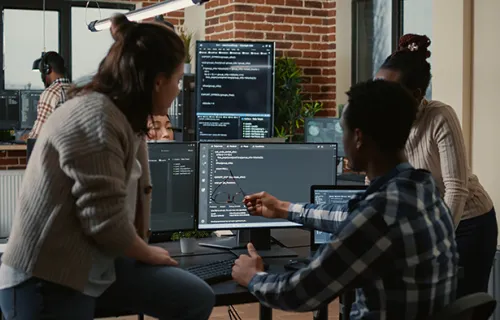I recently had the privilege of collaborating with clients who are now making strides in digital transformation, with a focus on intelligent automation. In order to achieve this transformation, we partnered with these clients to refresh their organizational capabilities and bring additional maturity to their enterprise architecture. Earlier in their hike toward digital transformation, our clients wished to establish a strong kinship and collaboration between the business and IT, and to make informed decisions that result in digital transformation. To adequately support their mission, our clients required business solutions that combined proven and emerging technology, built on a foundational technology platform that promotes innovation.
Many organizations set digital transformation goals to refresh legacy business processes and modernize legacy systems within a given timeframe, and hopefully within an established budget. However, their modernization efforts often fail to produce business results, or result in failed investments in IT solutions that lead to budget overruns. Some organizations abandon modernization efforts before they are complete.
To achieve good results, while resolving challenges and mitigating risks, organizations must promote and empower enterprise architecture. CGI recommends a risk- and cost-driven approach to enterprise architecture. Transforming our clients into digital organizations involves more than deploying new digital systems. It also requires changing the way organizations acquire, deliver and operate their systems. In order to become more responsive to unpredictable business and technology changes and achieve business agility, we recommend our clients rely on collaboration, rather than control. This fundamental change in systems management achieves desired business agility.
At face value, enterprise architecture support for digital transformation seems to be about the analysis of technology options, decisions on preferred technology providers, setup of DevSecOps processes, etc. I wrote last year about how RPA introduces new responsibilities to enterprise IT teams, and my colleague Dave Fladung recently wrote about EA support for informed data-driven modernization decisions.
However, if you want to achieve digital transformation efficiency and a high return on your investment, you must take a holistic point of view for your organization. Further enable enterprise architecture by adding responsibilities in the following focus areas:
- Pivot towards economy of scale: Enterprise architects identify and categorize technology options to make decisions for broader organizational investment and creation of enterprise-wide reusable services. While evaluating capabilities, they factor in costs, but they do not always account for license models. This omission can prove costly if the organization later wants to expand a project across business areas, or gradually scale up reusable services. Ensure the chosen license brings economy of scale to the organization.
- Establish a product mindset for enterprise IT systems: Enterprise architects can enable organizations to establish a paradigm of continuous improvement and business alignment, which keeps IT systems current, effective and responsive to business and mission needs.
- Include technology roadmaps in strategic decisions: Software solutions have a lifecycle and continually evolve. As a result, enterprise architects must consider not only current capabilities of available software solutions but also future development needs. With that roadmap in mind, enterprise architects can design systems for current needs but build in flexibility and plan expansions so that the systems continue to meet business needs over time.
- Support niche technology within overall digital transformation: Enterprise architects make technology decisions based on applicability across the organization. However, specific business areas in the organization require specialized, niche technology, such as a COTS product that provides process automation and predictive analytics for the acquisition business. Technology that does not have widespread applicability often falls lower on the priority list for evaluation, authorization and investment. However, not implementing these niche products can hamper the overall digital transformation.
- Enable superior budgeting and investment: The ever-increasing list of mission priorities struggles within the constraints of existing funding, often delaying digital transformation. Shifting from a capital expenditure (CapEx) model to an operational expenditure (OpEx) model creates opportunities as it frees up valuable resources, makes future spending more predictable, lowers costs and reduces expenditure. While not responsible for budgets or the budgeting process, enterprise architects have the opportunity to shift technology investment from CapEx to OpEx, thus introducing agility. They achieve this via cloud migration, use of low-code platforms, server-less computing, cloud-native API based application design patterns, etc. This shift reduces experimentation cost and enables proofs of concept and pilots, which are essential for digital transformation.
- Define a strong cybersecurity posture for emerging technology: By definition, emerging technology is less understood than established technologies and invites cybersecurity challenges. Alongside education of stakeholders, enterprise architects must support the definition of boundaries and constraints for experimentation with emerging technology to form a strong cybersecurity posture. A common example is credentialing for non-person entities (NPEs), which are neither services nor human. At several federal government agencies, enterprise architects collaborated with agency security officers to define credentialing for NPEs that unblocked intelligent automation. Needless to say, the cybersecurity posture needs continuous evaluation as new threat vectors emerge.
With higher enterprise architecture maturity, digital transformation becomes more achievable. Have you ever pondered if there’s a proven process that supports agility and efficiency in achieving maturity with enterprise architecture? If so, I invite you to review CGI’s Risk and Cost Driven Architecture (RCDA). A responsive and collaborative approach to digital architecture, RCDA combines the extensive scope of enterprise architecture with the pragmatism and agility of modern software development. As a recognized method in the Open Group Certified Architect program, RCDA has supported many successful implementations.
If you wish to learn more about RCDA, please feel free to reach out to me or to my colleague, Dr. Eltjo Poort.





